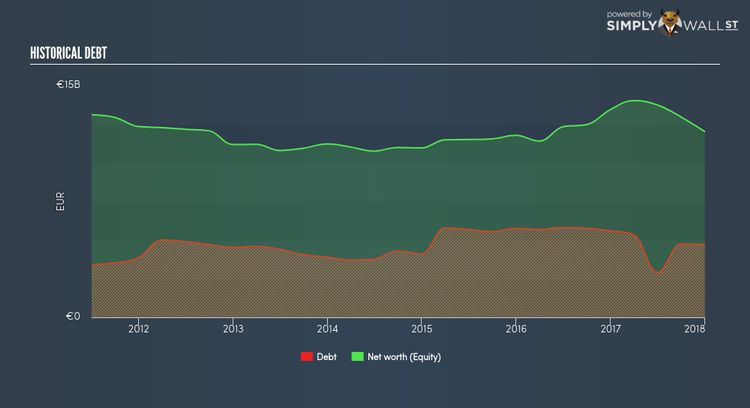What does Koninklijke Philips NV.’s (AMS:PHIA) Balance Sheet Tell Us About Its Future?

There are a number of reasons that attract investors towards large-cap companies such as Koninklijke Philips NV. (ENXTAM:PHIA), with a market cap of €30.13B. Risk-averse investors who are attracted to diversified streams of revenue and strong capital returns tend to seek out these large companies. But, the key to extending previous success is in the health of the company’s financials. Let’s take a look at Koninklijke Philips’s leverage and assess its financial strength to get an idea of their ability to fund strategic acquisitions and grow through cyclical pressures. Note that this information is centred entirely on financial health and is a high-level overview, so I encourage you to look further into PHIA here. View our latest analysis for Koninklijke Philips
Does PHIA produce enough cash relative to debt?
PHIA has shrunken its total debt levels in the last twelve months, from €5.61B to €4.72B , which is made up of current and long term debt. With this debt repayment, PHIA currently has €1.94B remaining in cash and short-term investments for investing into the business. On top of this, PHIA has generated €2.93B in operating cash flow over the same time period, leading to an operating cash to total debt ratio of 62.19%, meaning that PHIA’s operating cash is sufficient to cover its debt. This ratio can also be a sign of operational efficiency as an alternative to return on assets. In PHIA’s case, it is able to generate 0.62x cash from its debt capital.
Can PHIA pay its short-term liabilities?
With current liabilities at €6.87B, the company has been able to meet these obligations given the level of current assets of €10.12B, with a current ratio of 1.47x. Generally, for Medical Equipment companies, this is a reasonable ratio since there’s sufficient cash cushion without leaving too much capital idle or in low-earning investments.
Can PHIA service its debt comfortably?
PHIA’s level of debt is appropriate relative to its total equity, at 39.23%. PHIA is not taking on too much debt commitment, which can be restrictive and risky for equity-holders. We can check to see whether PHIA is able to meet its debt obligations by looking at the net interest coverage ratio. Net interest should be covered by earnings before interest and tax (EBIT) by at least three times to be safe. In PHIA’s case, the ratio of 21.63x suggests that interest is comfortably covered. Large-cap investments like PHIA are often believed to be a safe investment due to their ability to pump out ample earnings multiple times its interest payments.
Next Steps:
PHIA’s high cash coverage and appropriate debt levels indicate its ability to utilise its borrowings efficiently in order to generate ample cash flow. In addition to this, the company exhibits proper management of current assets and upcoming liabilities. I admit this is a fairly basic analysis for PHIA’s financial health. Other important fundamentals need to be considered alongside. I suggest you continue to research Koninklijke Philips to get a better picture of the stock by looking at:
Future Outlook: What are well-informed industry analysts predicting for PHIA’s future growth? Take a look at our free research report of analyst consensus for PHIA’s outlook.
Valuation: What is PHIA worth today? Is the stock undervalued, even when its growth outlook is factored into its intrinsic value? The intrinsic value infographic in our free research report helps visualize whether PHIA is currently mispriced by the market.
Other High-Performing Stocks: Are there other stocks that provide better prospects with proven track records? Explore our free list of these great stocks here.
To help readers see pass the short term volatility of the financial market, we aim to bring you a long-term focused research analysis purely driven by fundamental data. Note that our analysis does not factor in the latest price sensitive company announcements.
The author is an independent contributor and at the time of publication had no position in the stocks mentioned.

